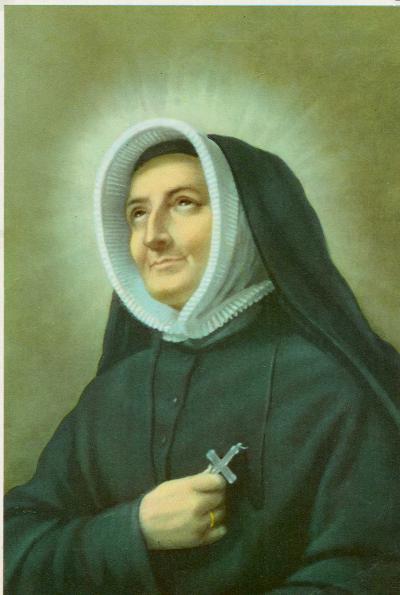 Saint Madeleine Sophie Barat (1779-1865)
Saint Madeleine Sophie Barat (1779-1865)
Madeleine-Sophie Barat was born in 1779, daughter of a wine cooper in the little Burgundian town of Joigny in France. After an extraordinary education by her priest brother, she went with him to Paris in 1795 to complete her training. There on November 21, 1800, Madeleine Sophie and three other young women consecrated themselves to the Sacred Heart of Jesus. In 1806, she was elected superior general and became the cornerstone of the Society of the Sacred Heart, whose purpose was to make known the love of God revealed in the Heart of Christ, and to take part in the restoration of Christian life in France through the education of young women.
The Society of the Sacred Heart quickly expanded within Europe and beyond. At the same time, Sophie Barat learned to counterbalance her learned view of God as a harsh judge with her experience of the love of God revealed in the Heart of Christ. Her natural capacity for friendship enabled a wide network of relationships. Her awareness of world events and their impact on education ensured the Society’s contribution to the promotion of women in her time and into the future. Her style of leadership tended towards consultation rather than decree, and to accepting the realistic option, rather than the impossible ideal. Her model of leadership through relationships was tested several times, especially from 1806 to 1815 and 1839 to 1851.
Her habit of a deep life of prayer and reflection, consistently found in her 14,000 extant letters, was stressed in the original Constitutions of the Society of the Sacred Heart of 1815 and reaffirmed in the revised Constitutions of 1982. It remains a vital legacy to the Society and to the wider Christian community.
At the time of her death on May 25, 1865, Sophie Barat was guiding an international community of over 3,000 women, which today extends to 41 countries.
No authentic portrait of Sophie Barat exists from her lifetime, since she refused to allow her photograph to be taken. A photograph taken on her death bed became the source of several later portraits.
Madeleine Sophie Barat was canonized a saint of the Roman Catholic Church on May 25, 1925. Her feast is kept on May 25.
Saint Rose Philippine Duchesne (1769-1852)
 Rose Philippine Duchesne was born in Grenoble, France, on August 29, 1769, into family actively involved in political and commercial life. Educated by the Visitation nuns at Sainte Marie d’en Haut monastery, she was drawn to their life of contemplation. She entered the congregation when she was 19, against the wishes of her family.
Rose Philippine Duchesne was born in Grenoble, France, on August 29, 1769, into family actively involved in political and commercial life. Educated by the Visitation nuns at Sainte Marie d’en Haut monastery, she was drawn to their life of contemplation. She entered the congregation when she was 19, against the wishes of her family.
The French Revolution soon forced the nuns to leave the monastery, and Philippine returned to her family. For 11 years, she risked her freedom and life by nursing prisoners, bringing priests to the faithful, and teaching and feeding poor children. At the close of the war, she gained title to Sainte Marie d’en Haut and opened a boarding school. In December 1804, she met Madeleine Sophie Barat, who in 1800 had founded the Society of the Sacred Heart. Philippine immediately turned over Sainte Marie d’en Haut and entered the Society.
A deep friendship formed between these two remarkable women of such different temperaments. For 12 years, the patient wisdom of Sophie molded the ardent, steadfast Philippine into a religious called to glorify the Heart of Jesus. Philippine, whose greatest joy was to spend whole nights in prayer, soon felt a call to serve as a missionary. Many times, Philippine shared with Sophie her dream of bringing the Gospel to the native peoples in America, but her skills were needed at home, first in the school at Sainte Marie, and from 1815 as the Society’s secretary general.
Her dream was realized when Sophie accepted Bishop William Du Bourg’s invitation to establish schools for the Native Americans and French children in the diocese of Louisiana. Philippine Duchesne, Eugénie Audé, Octavia Berthold, Marguerite Manteau, and Catherine Lamarre set sail for North America on the Rebecca, March 21, 1818, landing on near New Orleans on the Feast of the Sacred Heart, May 29, 1818, and from there they traveled to St. Louis, Missouri.
At the direction of Bishop Dubourg, Philippine and her companions went to St. Charles, Missouri, across the Missouri River, where on September 14, 1818, they opened the first Sacred Heart school outside of Europe. It was also the first free school west of the Mississippi and the first Catholic school in what would become the Saint Louis archdiocese. By the next year, they relocated to Florissant, Missouri, where in 1820, Mother Duchesne opened the first novitiate. Other schools soon followed in Missouri and Louisiana. Eventually there were six schools.
In 1841, Philippine and three other Religious of the Sacred Heart went to Sugar Creek, Kansas, to establish a school for Potawatomi girls. At 72, too frail to do physical work, and unable to learn the Potawatomi language, she spent much of her time in prayer, gaining the name “Woman Who Is Always Praying.” After just one year, she was recalled to St. Charles, her original foundation, where she died on November 18, 1852, at age 83, having spent 34 years in America.
Philippine and the first RSCJ in the United States became dependent on the forced labor of enslaved people during their initial years in North America. This practice was entrenched in the economy and civil society of Missouri and Louisiana and was supported by Catholic Church leaders. We know that complicity in the institution of enslavement denied the dignity of people of color and was sinful. The Society is working humbly to acknowledge our history with enslavement, to build relationships with the descendants of people enslaved by the Society, and to work with the descendants towards racial equity and the end to systemic racism in our institutional structures.
It was later admirers of Philippine who initiated her process of canonization in the Catholic Church. She was declared a saint of the Catholic Church in 1988. Her Feast Day is November 18.
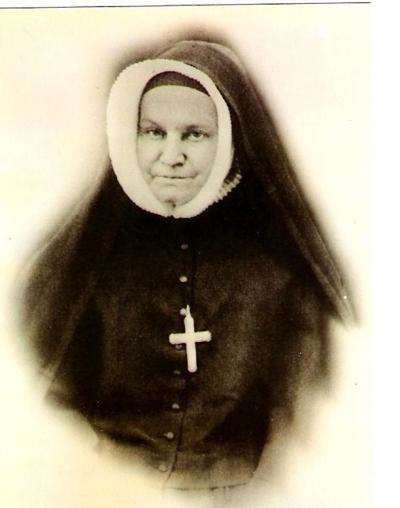 Mary Aloysia Hardey (1809-1886)
Mary Aloysia Hardey (1809-1886)
Mary Ann Aloysia Hardey, a central figure in the expansion of the Society of the Sacred Heart in North America, was born in Piscataway, Maryland, December 8, 1809, of a farming and slaveholding family. As a child, Mary Ann moved with her family and household to Opelousas, Louisiana, and in 1822, she was enrolled as a student at the Convent of the Sacred Heart in nearby Grand Coteau. Upon completing her studies in 1825, Mary Ann entered the novitiate of the Society of the Sacred Heart at Grand Coteau and took the name Aloysia. The day after she received the habit of a novice, she departed with Eugénie Audé for the foundation of Saint Michael, a new school closer to New Orleans. Her first vows were advanced seven months in 1827 so that she could be put in charge of the school. A young religious of many talents, she made her final profession in 1833 at the age of twenty-four, and a few months later was named superior, a charge she would bear for the rest of her life.
In 1840, Aloysia Hardey moved to New York City where the first school and convent of the Society of the Sacred Heart in the eastern United States had been opened. In 1844, she was charged with the houses in eastern North America. During her twenty-seven years as superior, Mother Hardey opened sixteen houses of the Sacred Heart from Canada to Cuba, and throughout the eastern United States. She moved the center of the vicariate from Manhattanville in New York City to Kenwood, Convent of the Sacred Heart in Albany, New York, where she established a new novitiate for the vicariate in 1864. She traveled extensively and made nineteen transatlantic voyages for Society meetings and retreats.
In 1871, Mother Hardey was appointed assistant general of the Society of the Sacred Heart based in Paris. During her fifteen years in this position, she assisted the superior general in founding and rebuilding European convents. She also returned to the United States occasionally to attend to business concerning the American houses.
Aloysia Hardey died in Paris June 17, 1886. After the Religious of the Sacred Heart left France in the early 1900s, her remains were brought back to the United States; she is buried at Kenwood.
Eliza (Liza) Nesbit (Nebitt) (c. 1812-1889)
“a Colored chile of the Sacred Heart” in her own words
Born about 1812 in Kentucky, Eliza was said to be a gift to Philippine Duchesne from Bishop Dubourg around 1821 or 22. Recent research indicates she may have been the daughter of an enslaved couple, Henry (Harry) and Jenny, also held by the bishop. She possibly had siblings, one of whom, Sarah, named her in a bank application in 1872. Sarah, living in New Orleans, indicated that her parents were Henry Nebit/Nobit and Jenny Burch and that she had a sister Eliza living in Saint James parish, where the school, Saint Michael, was located from 1825.
Eliza accompanied Eugénie Audé and companions to found the academy of Saint Michael in what became known as Convent, Louisiana. She became close to the Society, and her dream was to become a member. However, segregation laws in the South meant that she would never be able to join.
She married at least twice. In the 1870 census, she had five children with her, one of whom is also with her in 1880 as her nephew. Society records mention that one marriage was unhappy, and the spouse disappeared with Eliza’s property. Neither marriage appears in church records, which are sparse for the dates covered.
Liza’s strong personality comes out in three extant letters and in stories about her in the annual newsletters of the Society, which mention her three times. She was determined to be buried with the RSCJ, even if she could not join them in life. This request was granted by the superior general.
At the end of her life, she dedicated herself each Pentecost Sunday by a vow of charity as a Sister of Charity of the Sacred Heart. The public ceremony, with the vow made to serve the sick and needy, took place in front of the assembled community and concluded with the singing of the Magnificat.
When Eliza died in 1889, she was mourned by both RSCJ and the black population of Convent. The account of her last hours and her burial merited a long mention in the Annual Letters of the convent of Saint Michael that year.
Josephine Gœtz (1865-1874)
Upon the death of Mother Barat in 1865, Mother Josephine Gœtz, from Alsace-Lorraine, was elected superior general. Self-declared “arch-orthodox,” her aim was to conserve and deepen the spirit of the founder by “creative fidelity.” Mother Goetz fostered the study of philosophy and consolidated teacher training. Wars and political unrest in Europe prevented further spread of the Society. She invited the first American religious to the motherhouse as a member of her council, Mother Aloysia Hardey. Mother Gœtz died in 1874 after a relatively short term.
Mabel Digby (1895-1911)
An Englishwoman and a convert to Roman Catholicism, Mother Digby guided the Society through turbulent events of French history in the first decade of the twentieth century. Between 1906 and 1909, the Masonic government of France forbade religious to teach, thereby forcing the closing of forty-seven houses of the Society in that country. Under Mother Digby’s direction, 2500 religious were dispersed to other countries. But for each house closed, another was opened, as far away as Japan. From a temporary motherhouse in Ixelles, Belgium, Mother Digby directed the Society’s growth. In 1900, the Society celebrated its centenary and, in 1908, the beatification of Madeleine Sophie Barat, the recognition by the Church of the holiness of the founder.
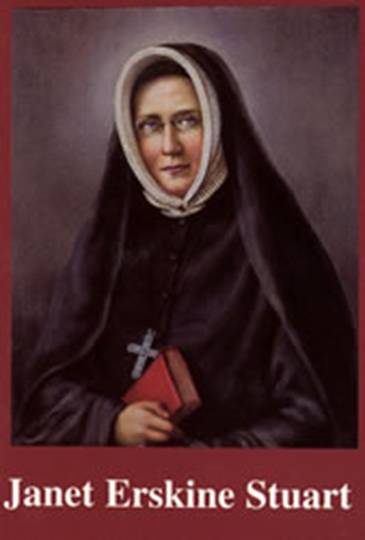 Janet Erskine Stuart (1857-1914)
Janet Erskine Stuart (1857-1914)
Janet Erskine Stuart was born November 11, 1857, in Cottesmore, Rutland, England. Her father was the Anglican rector. At the age of fourteen, Janet set out on a solitary search for Truth, having been urged to this venture by a casual remark of one of her brothers that every rational creature must have a last end. The search for this last end, she said, took seven years and brought her to the Catholic Church at the age of twenty-one. In 1882, she entered the Society of the Sacred Heart at Roehampton, outside of London, where she was to spend thirty years of her religious life. Named mistress of novices soon after her final profession, she became superior in 1894, and seventeen years later was elected the sixth superior general of the Society of the Sacred Heart. Believing in the importance of knowing personally all the members of the Society, she undertook to travel around the world visiting all her houses. At the conclusion of her journey, the Society looked forward to a long and fruitful period of renewal under her leadership, but illness took her life at the early age of fifty-seven, on October 21, 1914, a few months after the outbreak of World War I.
She left the legacy of commitment to intellectual excellence as well as spiritual intensity. She believed that “epochs of transition must keep us on the alert; the mind must keep flexible in order to…acquire any knowledge that can aid our mission.”
Janet Stuart’s influence extends throughout the world, primarily through her writings and her biography, Life and Letters of Janet Erskine Stuart. Religious of the Sacred Heart as well as many other congregations and individuals committed to spiritual growth and educational excellence have been inspired by her letters, conferences, essays, and poetry. Among Mother Stuart's best known works are Highways and By-ways in the Spiritual Life, (1909) and The Education of Catholic Girls (1912).
Marie-Thérèse de Lescure (1946-1957)
After World War II, the Society elected as superior general the first French woman from France since Saint Madeleine Sophie, Marie-Thérèse de Lescure. Her watchword was élargir, a broadening in response to need. She stressed advanced studies for the religious, wide reading of the best modern authors, and, above all, a deepening of the life of prayer. Mother de Lescure visited 103 houses in eighteen countries, oversaw a complete rewriting of the Plan of Studies, and composed Life at the Sacred Heart, a descriptive booklet of life in the boarding school to replace the old rule of the school. Open to contemporary thinking, she was intransigent on one point: cloister as it was practiced in the Society was to be maintained.
Sabine de Valon (1958-1967)
In the mid-twentieth century, Sabine de Valon (1958-1967) brought the Society face to face with the realities of today. She was an official auditor at sessions of Vatican Council II, called by Pope John XXIII. Among its calls was an appeal for the renewal of religious life in the Church. The Society of the Sacred Heart carried out the mandates of Vatican II by defining itself as an apostolic community and abolishing cloister at the General Chapter of 1964. Mother de Valon gave a strong missionary thrust to the Society’s action, and encouraged an energetic response to the universal cry for social justice, calling for participation in education in areas of urban poverty and a greater social diversity in the schools. She started the worldwide association of alumnae of Sacred Heart schools and developed a program for volunteers to serve in the Society’s missions. She convoked a special chapter in 1967 to comply with the mandate of Vatican II that all religious orders examine their lives and customs. In the course of that chapter Mother de Valon, elected for life, resigned, the first superior general to do so. In the light of her action and as part of governmental revisions, superiors general from then on are elected for a specified term.
Concepción Camacho (1970-1982)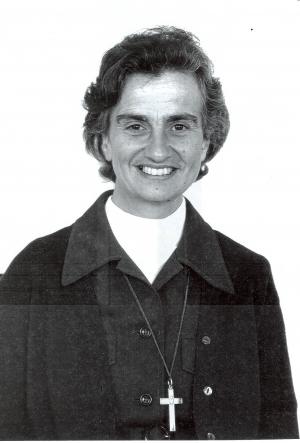
At the General chapter of 1970, Concepción Camacho, a Spaniard, was elected superior general. Her task was to oversee the renewal of the Society in the light of the decisions and calls of the two chapters of 1967 and 1970. Although the enduring mission of education was affirmed, the forms it was to take and the populations it was to serve were both broadened. Community life too was differently structured; it was to be simpler and more flexible, based on close relationships, relying less on rules and schedules and more on mutually discerned practice. Concha Camacho and her council, “team,” traveled around the Society together living their community life in the midst of the communities they were visiting. This emphasis on the renewal of community life, along with profound spiritual renewal, characterized Concha’s twelve years in office.
Gertrude Bodkin (1875-1966)
Generations of Religious of the Sacred Heart in North America were trained as novices by Mother Bodkin, an Irish woman sent to the United States in 1909 to take charge of the novitiate. She was one of four sisters who entered the Society of the Sacred Heart in England. She had been a novice under Mother Stuart, and her teaching showed the effect of Mother Stuart’s training. It was strong and intellectually based. While directing the novitiate, a responsibility she held for twenty-two years, she herself earned a doctorate in philosophy from Fordham University. Then, in 1931, she was named superior vicar of the houses of the Society on the East Coast, an office she held until 1953. Her last years were spent at Kenwood where she continued to be a beloved advisor to many religious.
Marie Louise Schroen (1909-1991)
The daughter of a Cuban mother and a German father, Marie Louise Schroen was born in Italy, but her mother brought her to the United States at the outbreak of World War I. She was educated partly in the United States and partly in Italy after the war. She finished her studies at Manhattanville College of the Sacred Heart in New York and then entered the Society, under the direction of Mother Bodkin. After making her first vows, Mother Schroen began teaching at the college and studying for her doctorate at the same time; but her academic career was interrupted when, in 1945, she was named mistress of novices at Kenwood, a position she held until 1959. She was happy, in 1948, to have been the one to receive the first African-American woman to enter the Society.
Mother Schroen always maintained a lively interest in theology and church history and above all in Scripture, in which she was mostly self-taught. She passed this interest and enthusiasm to her novices and later to the young religious preparing for final vows at the motherhouse in Rome. She had charge of this program, probation, just at the time of the Second Vatican Council, 1963-1965. She was acquainted with some of the theologians at the Council, whom she invited to speak to the probation. Some of their teaching—and hers—was rather far ahead and disturbed some superiors. Mother Schroen soon found herself in Korea. Then began an itinerant life teaching and giving workshops on Scripture and the theology of Vatican II. When she returned to the United States, in 1969, she created for herself a ministry of teaching the Bible to laywomen in parishes around Greenwich, Connecticut, where she lived. She continued teaching and giving retreats to religious communities, RSCJ and others. All her life, no matter what group she worked with, she shared her love of the Word of God.
She died at Kenwood after a short illness on January 13, 1991.
Mary Cecelia Wheeler (1908-1999)
The archives of the Society of the Sacred Heart at the central level and in the United States-Canada Province owe their existence to Mary Cecelia Wheeler, who single-handedly created a central archival collection that preserves the legacy of the Society and its founders. Born into a large family in Pittsburgh in 1908, Mary Cecelia Wheeler was sent to Kenwood to school. Her education there by the Religious of the Sacred Heart led her to enter the Society, even though four of her sisters entered the Daughters of Charity. Her early years were spent teaching and directing the studies in several Sacred Heart schools.
After earning the doctorate, she taught philosophy at Newton College of the Sacred Heart for several years. In 1973, as plans were in the making for the merger of the five provinces in the United Sates, she was asked to organize and centralize their records, in effect, to create an archive. She performed the same service for the international Society in Rome, creating a system and implementing it. Upon returning home, she assisted in the provincial archives for many years; during her last years she was school archivist at the Doane Stuart School in Albany. Her love of history and her enthusiasm for the life story of the Society made her an ideal archivist. She died at Kenwood in 1999.
Catherine (Kit) Collins (1937-2010)
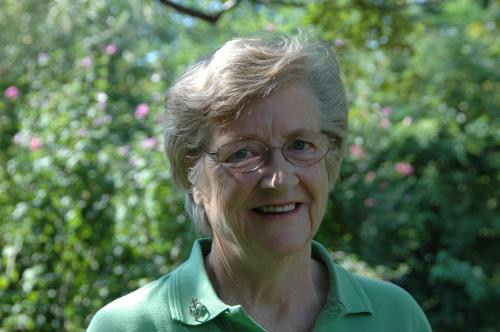 The Network of Sacred Heart Schools that exists today in the United States and Canada is the product of the genius of Catherine Collins. A Bostonian, she was educated at Newton Country Day School of the Sacred Heart and Manhattanville College. She entered the Society of the Sacred Heart after college and, following the novitiate, quickly found herself directing the academics at one of the schools in Philadelphia. It was the 60s, a time of upheaval in the country, the Church, and the Society of the Sacred Heart. Young Sister Collins, Kit by now, had some forward-looking ideas about education and surrounded herself with people who shared them. She was briefly a headmistress at Stone Ridge School of the Sacred Heart in Bethesda, Maryland, after which she was appointed coordinator of the schools in the Washington Province, then of those in the whole United States. In this capacity, she developed the Network, a consortium of schools with a common philosophy of education, the philosophy inherited from Saint Madeleine Sophie, Working out a statement of that philosophy, a means of formation of the educators to that philosophy, and a system of accountability for its practical implementation was the work of many years and is ongoing.
The Network of Sacred Heart Schools that exists today in the United States and Canada is the product of the genius of Catherine Collins. A Bostonian, she was educated at Newton Country Day School of the Sacred Heart and Manhattanville College. She entered the Society of the Sacred Heart after college and, following the novitiate, quickly found herself directing the academics at one of the schools in Philadelphia. It was the 60s, a time of upheaval in the country, the Church, and the Society of the Sacred Heart. Young Sister Collins, Kit by now, had some forward-looking ideas about education and surrounded herself with people who shared them. She was briefly a headmistress at Stone Ridge School of the Sacred Heart in Bethesda, Maryland, after which she was appointed coordinator of the schools in the Washington Province, then of those in the whole United States. In this capacity, she developed the Network, a consortium of schools with a common philosophy of education, the philosophy inherited from Saint Madeleine Sophie, Working out a statement of that philosophy, a means of formation of the educators to that philosophy, and a system of accountability for its practical implementation was the work of many years and is ongoing.
A second major project was the creation of the Center for Educational Design and Communication. Offering communication and media services to the province, to other religious orders, and to non-profit groups involved in work for justice, the Center put Kit in touch with a variety of people and groups whose concerns she shared and with whom she and her staff worked. The Center continues as part of the United States-Canada Province’s Stuart Center in Washington, D.C..
Kit had health problems throughout her life, but she was in full activity at the Center, so no one expected her sudden death on March 14, 2010. She left a legacy of energetic dedication to Sacred Heart education in its many forms and commitment to the work for justice. A biography of Kit Collins is in preparation.
